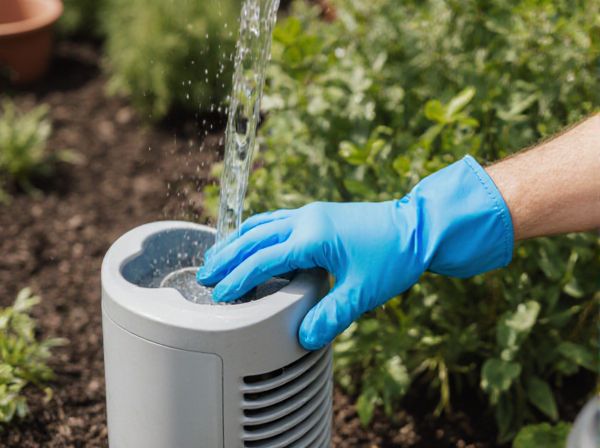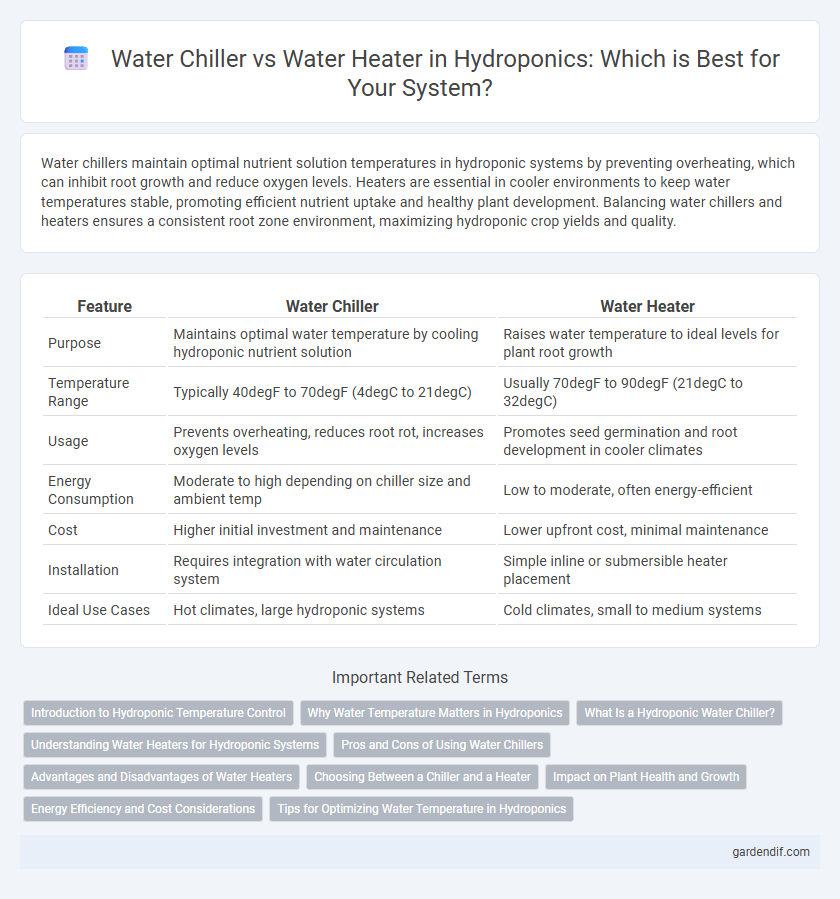
Water Chiller vs Heater Illustration
Water chillers maintain optimal nutrient solution temperatures in hydroponic systems by preventing overheating, which can inhibit root growth and reduce oxygen levels. Heaters are essential in cooler environments to keep water temperatures stable, promoting efficient nutrient uptake and healthy plant development. Balancing water chillers and heaters ensures a consistent root zone environment, maximizing hydroponic crop yields and quality.
Table of Comparison
| Feature | Water Chiller | Water Heater |
|---|---|---|
| Purpose | Maintains optimal water temperature by cooling hydroponic nutrient solution | Raises water temperature to ideal levels for plant root growth |
| Temperature Range | Typically 40degF to 70degF (4degC to 21degC) | Usually 70degF to 90degF (21degC to 32degC) |
| Usage | Prevents overheating, reduces root rot, increases oxygen levels | Promotes seed germination and root development in cooler climates |
| Energy Consumption | Moderate to high depending on chiller size and ambient temp | Low to moderate, often energy-efficient |
| Cost | Higher initial investment and maintenance | Lower upfront cost, minimal maintenance |
| Installation | Requires integration with water circulation system | Simple inline or submersible heater placement |
| Ideal Use Cases | Hot climates, large hydroponic systems | Cold climates, small to medium systems |
Introduction to Hydroponic Temperature Control
Hydroponic temperature control is critical for optimizing plant growth, with water chillers and heaters serving complementary roles to maintain ideal nutrient solution temperatures between 65-75degF (18-24degC). Water chillers prevent root zone stress by lowering excessive temperatures that inhibit nutrient uptake, while heaters ensure consistent warmth during cooler periods to promote metabolic activity. Effective management of hydroponic water temperature directly influences oxygen availability, nutrient absorption, and overall crop yield.
Why Water Temperature Matters in Hydroponics
Water temperature in hydroponics directly affects nutrient uptake and oxygen levels, influencing plant growth and root health. Chillers maintain optimal cooler temperatures to prevent root diseases and reduce metabolic stress, while heaters ensure warmth during colder periods to promote nutrient absorption and steady growth. Precise temperature control stabilizes the hydroponic environment, maximizing crop yield and overall system efficiency.
What Is a Hydroponic Water Chiller?
A hydroponic water chiller is a specialized cooling device designed to regulate water temperature in hydroponic systems, ensuring optimal nutrient uptake and plant growth. By maintaining water temperatures between 65degF and 72degF, it prevents root diseases and enhances oxygen levels in the nutrient solution. Unlike water heaters that raise temperature, water chillers effectively combat heat stress in indoor and greenhouse hydroponics, promoting healthier plant development.
Understanding Water Heaters for Hydroponic Systems
Water heaters for hydroponic systems regulate nutrient solution temperature to promote optimal root growth and prevent thermal stress. Maintaining temperatures between 65degF and 75degF ensures efficient nutrient uptake and reduces the risk of root diseases. Selecting a heater with precise temperature control and energy efficiency is crucial for stable hydroponic system performance.
Pros and Cons of Using Water Chillers
Water chillers effectively regulate nutrient solution temperature in hydroponic systems, preventing root overheating and promoting optimal oxygen levels, which enhances plant growth and yield. They consume significant energy and can be costly to install and maintain, making them less suitable for small-scale setups. Despite the upfront costs, water chillers provide precise temperature control essential for sensitive crops requiring consistently cool root zones.
Advantages and Disadvantages of Water Heaters
Water heaters in hydroponic systems maintain optimal nutrient solution temperatures, promoting faster plant growth and preventing root diseases caused by cold stress. Advantages include consistent temperature control and enhanced nutrient uptake, while disadvantages involve higher energy consumption and the risk of overheating, which can harm sensitive plant roots. Proper thermostat settings and insulation are essential to maximize efficiency and minimize operational costs.
Choosing Between a Chiller and a Heater
Selecting between a water chiller and a heater in hydroponic systems depends on the target nutrient solution temperature, crucial for optimizing plant growth and preventing root diseases. Water chillers maintain temperatures typically between 65degF to 70degF, ideal for cooling nutrient reservoirs in warm environments, while heaters are used to raise temperatures to approximately 72degF to 75degF in cooler settings. Monitoring temperature fluctuations within this optimal range supports nutrient uptake and promotes healthy hydroponic plant development.
Impact on Plant Health and Growth
Water chillers regulate nutrient solution temperature to prevent root zone heating, which can reduce oxygen levels and cause root damage, promoting healthier root systems and higher growth rates. Water heaters maintain optimal warmth in cooler environments, ensuring enzymatic activity and nutrient uptake remain efficient, supporting robust plant development. Balancing these systems in hydroponics directly influences root metabolism and overall plant health, maximizing yield quality and growth consistency.
Energy Efficiency and Cost Considerations
Water chillers in hydroponic systems consume significant energy to maintain optimal root-zone temperatures, often resulting in higher operating costs compared to heaters. Heaters generally use less electricity, especially when maintaining moderate temperature increases, making them more cost-efficient for small to medium setups. Energy-efficient models with precise temperature controls reduce waste, but initial investment for chillers tends to be higher, impacting long-term cost-effectiveness based on climate and system scale.
Tips for Optimizing Water Temperature in Hydroponics
Maintaining optimal water temperature in hydroponics requires precise control using water chillers or heaters based on ambient conditions and crop requirements. Water chillers efficiently reduce temperature to prevent root stress and inhibit pathogen growth, while heaters maintain consistent warmth vital for tropical plants and seedling development. Regular monitoring with a digital thermostat and insulating water lines can prevent temperature fluctuations, ensuring nutrient solution stability and maximizing plant growth.
Water Chiller vs Heater Infographic

 gardendif.com
gardendif.com